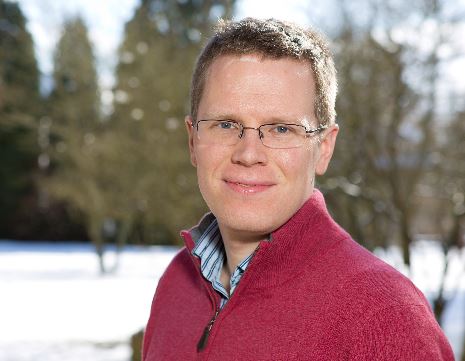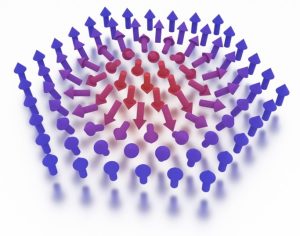Ferromagnetic materials, such as iron and cobalt, can be thought of as consisting of many individual magnets called spins. If a piece of iron is magnetised, this corresponds to all spins pointing in the same direction. In contrast, a random orientation of all spins would give rise to an unmagnetised material. But the spins can also have other interesting shapes. Imagine tiny, swirling patterns of spins within a material – that’s a skyrmion (see picture). They are not just static magnetic vortices but dynamic entities that could revolutionise how we store and process information.
Depending on the host material, skyrmions come in very different sizes. While large skyrmions (with sizes on the order of micrometers) follow the laws of classical magnetism, smaller skyrmions (with nanometer sizes) start to behave according to the laws of quantum mechanics. At the nanoscale therefore, these structures become truly fascinating and potentially pave the way towards game-changing technologies – reaching from quantum bits for quantum computers to quantum sensors.
‟ It’s not just about making things smaller. Spin is a fundamentally quantum-mechanical property of atoms, so we should understand better how quantum effects influence magnetic skyrmions. Only then can we hope to achieve the required level of control for advanced technical applications”

Full professor in Physics
Together with researchers from the University of Konstanz, his team developed a method to represent quantum skyrmions as individual particles with a magnetic polarization surrounded by a cloud of quantum mechanical spin fluctuations. The researchers discovered that compared to classical magnetic skyrmions, quantum skyrmions become fuzzy and have quantum entanglement, an important resource for quantum technologies which transcends the laws of classical physics.
The teams demonstrated that their method faithfully captures the essential properties of quantum skyrmions and effectively treats them as individual particles called bosons. This method for modelling quantum skyrmions is computationally much more efficient than standard approaches for quantum mechanical simulations of skyrmions, so it makes it possible to numerically study properties which have hitherto been inaccessible, e.g., in larger systems hosting many skyrmions.
‟ At the nanometer scale, skyrmions become fuzzy quantum particles. As such, they can violate the laws of classical mechanics. For instance, they can tunnel through energy barriers, appear in superposition states or form exotic many-body phases such as superfluids or Bose-Einstein condensates.”

Postdoctoral researcher and lead author
The team now investigates more in detail which conditions allow the existence of many-skyrmion states, and how they can be created and controlled experimentally.
Similar to an electric charge, skyrmions have a so-called topological charge, which is connected to the orientation of the magnetic whirl. Just as positrons have an opposite electric charge to electrons, it is possible to create anti-skyrmions which have an opposite topological charge compared to skyrmions. In the context of a joint CORE grant with Prof. Andreas Michels, the two teams from the University of Luxembourg continue working on quantum skyrmions and currently investigate quantum superpositions of skyrmions and anti-skyrmions.
